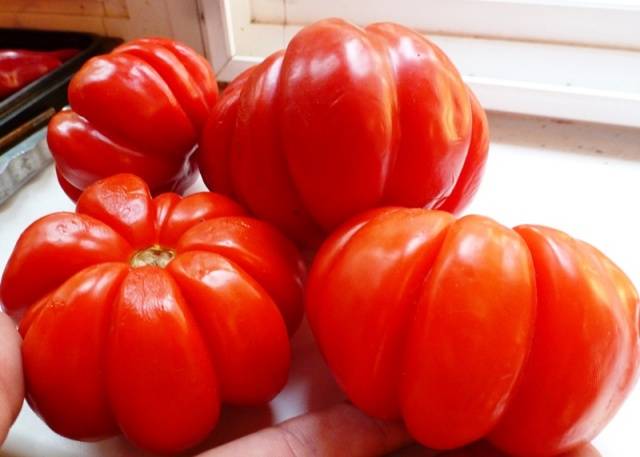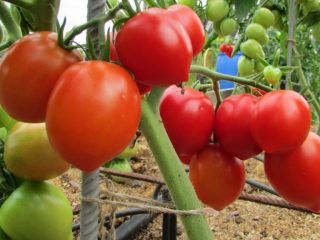Content
Few gardeners, or even just the owner of a personal plot, will refuse to grow tomatoes in their garden. Indeed, with the modern variety of varieties with their amazing characteristics and sometimes unusual appearance, it is not easy to limit yourself to eating only those tomatoes that are offered in markets and stores. And if you grow it yourself, then such an immense scope for choice opens up that it’s simply dizzying. And growing tomatoes is turning into a kind of hobby, which is akin to collecting. Only in this case you have to collect varieties of tomatoes, and the impressions associated with them remain, at best, in a photo or video. And the taste, unfortunately, is quickly forgotten. And it depends not only on the variety, but also on growing conditions and weather.
Of course, given the huge variety of tomato varieties, breeders go to great lengths to attract the attention of consumers to their new product. They often give varieties names that, once you hear them, you can’t help but become interested and simply pass by. The Puzata Khata tomato is intriguing by its very name.But besides its name, its appearance is so unusual that any gardener will definitely become interested and want to plant it on his plot.
What other qualities distinguish this variety of tomatoes, besides the intriguing name and equally unusual appearance? In the article, in addition to a description of the Puzata Khata tomato variety and its photo, you can also find many reviews from gardeners who have already tried to plant this variety on their plots.
History and description of the variety
Tomato Puzata Khata is a fairly new variety of Russian selection. It appeared in 2012 as a result of the work of a group of breeding scientists led by Vladimir Kachainik. It was registered in the State Register in 2013, the originator was the company “Aelita”, under whose brand the seeds of this variety are now mainly produced.
The tomato variety Puzata Khata belongs to the indeterminate varieties, that is, theoretically it has unlimited growth.
Since its stems are quite thin, and the bushes themselves cannot be called powerful, the weight of the fruit may cause the plants to become lodging, so tomatoes require obligatory gartering to a trellis and the formation of bushes. The bushes have average foliage levels, and they also branch at an average level.
The leaves are medium sized, dark green in color. The inflorescence is of an intermediate type. The stalk has no articulation. One brush usually forms up to 5 fruits.
Despite the fact that the Puzata Khata tomato variety is zoned throughout Russia, in most regions it is recommended to grow it in greenhouses, or at least using film covers.In open ground in the middle zone, according to reviews from gardeners, the Puzata Khata tomato may not have time to fully ripen or will be small in size. But in the south it can be safely planted in open ground - there the only problem in care can be timely and regular watering.
Although in the description of the variety in the State Register, the Puzata Khata tomato is classified as early ripening, that is, according to this characteristic it should ripen approximately 100 days after seed germination, many gardeners complain that the reddening of the fruit occurs very slowly and with a great delay. Apparently, this variety still has great sensitivity to the amount of positive temperatures and the amount of sunlight, which may not be enough for it to ripen in a timely manner in mid-latitudes.
Productivity is one of the advantages of the Puzata Khata variety; from one square meter of planting you can harvest about 9-11 kg of tomatoes.
The official description of the variety does not mention susceptibility to major tomato diseases, but, according to reviews, Puzata Khata tomatoes are quite resistant to late blight, and other diseases usually bypass it if minimal preventive measures are taken.
But it is quite sensitive to the composition of the soil on which it is grown - it is necessary that it be balanced in the content of all basic nutrients.
Fruit characteristics
It is rare that a tomato variety can boast such an unusual fruit shape as Puzata Khata.Not only is it heavily ribbed, but the shape itself is pear-shaped, as a result the fruit strongly resembles a purse gathered at the top, with which housewives used to go to the market.
The color of unripe fruits is light green, and there is no spot at the base. As tomatoes ripen, the color turns red, but rather with a hint of orange. There are from 4 to 6 seed nests in a tomato.
The fruits are large in size - on average their weight is 250-300 grams, but there are specimens reaching a weight of 700-800 grams. As often happens, the largest fruits on the bush are the largest, then gradually the tomatoes become smaller.
The skin of the fruit is thick enough to support the considerable weight of tomatoes without cracking. But you don’t feel it while eating. The pulp is quite juicy, but tomatoes often have voids, making them not very suitable for canning.
The taste is rated “4” by professional tasters; most gardeners recognize it as good, but far from excellent. Tomatoes of this variety contain a lot of sugar and virtually no acid, so they are especially suitable for dietary and baby food. The fruits of this tomato variety make excellent salads, as well as good purees and other preparations where the tomatoes are crushed and not used as a whole.
An obvious advantage of the Puzata Khata tomato variety is the good preservation of the fruit.They can be picked while still green, and they ripen easily and quickly on the windowsill and after that can be stored for quite a long time without changing their taste characteristics.
Thanks to this property, tomatoes of the Puzata Khata variety are easily transported over long distances, and therefore can be profitable for commercial cultivation. True, due to their unusual shape, tomatoes take up more space in a standard container.
Advantages and disadvantages of the variety
Summarizing all of the above, it is necessary to note that the Puzata Khata tomato variety has a number of advantages that set it apart from its peers:
- High yield, according to reviews, even sometimes exceeding the figures given in the official description of the variety;
- The fruits contain a lot of sugar and other beneficial elements;
- High preservation of fruits;
- Large size and unusual shape of tomatoes;
- Comparative resistance of tomatoes to major diseases.
Of course, the variety also has some disadvantages, which include, first of all, the following:
- The need for shaping and gartering due to some fragility of the bush;
- The requirements of the Puzata Khata tomato for soil fertility.
Growing and care
In general, tomatoes of the Puzata Khata variety are grown using standard technology for tomatoes, but there are still some peculiarities.
Seedling period
Since Puzata Hata tomatoes are a variety and not a hybrid, for sowing you can use both purchased seeds and those obtained from your own or your friends’ plants.
It is necessary to sow seeds in seedling containers approximately 60-65 days before planting the bushes in a permanent place.
Immediately after germination, it is advisable to place the sprouts under the brightest light you can find for them. In this case, the temperature must, on the contrary, be reduced by 5-10 degrees. This way, you can achieve good development of the root system, and at the same time increase the immunity of tomato plants.
After the first true tomato leaves appear on the tomato seedlings, the bushes must be planted in separate pots. A week after picking, it is advisable to feed the seedlings. Since the seedlings of this variety may look weaker compared to other tomatoes, it is advisable to feed them with small doses of fertilizer once a week. It is best to use humates with microelements or microbiological fertilizers such as Siyanie, Baikal and others.
Planting in the ground and further care
Since tomatoes of this variety require a mandatory garter, it is easier to initially plant the seedlings near the trellis. In this case, pruning and further tying of stems is noticeably simplified. No more than 3 tomato bushes of the Puzata Khata variety are planted per 1 square meter of bed.
It is advisable to form tomatoes of this variety into 1 or 2 stems.To form bushes with 2 stems, leave one stepson growing under the first flower cluster. All other stepsons and lower leaves are gradually removed. To form into 1 stem, all stepchildren are gradually and systematically removed, preventing them from growing more than 10 cm in length.
In order to get large tomatoes, it is advisable to form bushes into one trunk. If you have little space in the garden bed or in the greenhouse and you have to plant bushes more often, then in this case the only possible growing technology will be to form the plants into one trunk.
Plants of this variety are quite demanding on soil fertility, so they need a few more feedings after planting in the ground. Also regularly water the bushes with non-cold water, especially if the weather is hot and dry.
Tomatoes may ripen unevenly, so take care in advance of additional shelter for the bushes in case of early cold weather.
Reviews from gardeners
Reviews from summer residents and gardeners about the Puzata Khata tomato variety, the description and photo of which you could see above, are very diverse and sometimes contradictory. Perhaps this is due to different weather conditions when growing tomatoes, or perhaps there was a mis-sorting of seeds.
Conclusion
Despite the fact that the Puzata Khata variety appeared relatively recently, it has already managed to find both its fans and those who were disappointed in it. In such cases, there is only one way to get to the bottom of the truth - buy seeds and grow tomatoes of this variety yourself.





















Puzata hut from Aelita, planted in open ground, north of the Saratov region, they felt better than anyone, did not crack, did not get sick. But the mass is far from 300g. From 500 to 1200g, we grow them for juice and paste, in 2020 the tomatoes were too sweet, we fed them a lot of ash (herbal)
I planted this variety for the first time. Very pleased! Fruitful and good-tasting tomatoes. I will try to collect seeds for further cultivation.